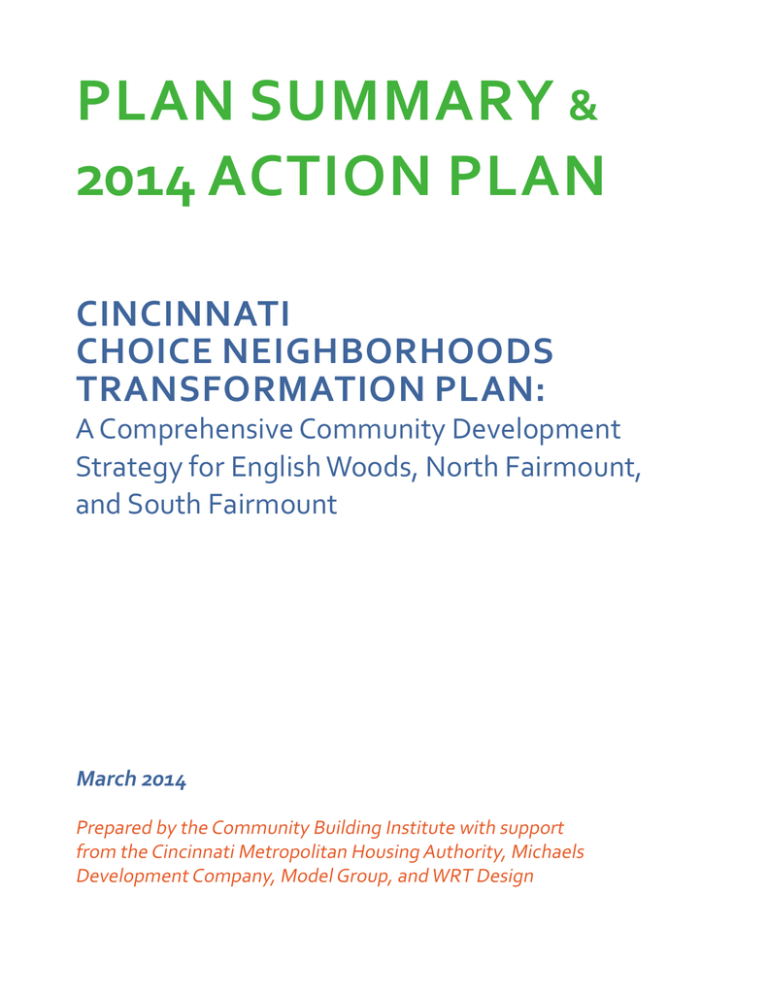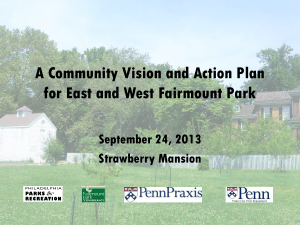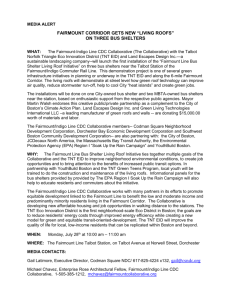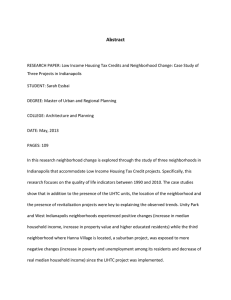PLAN SUMMARY 2014 ACTION PLAN & CINCINNATI
advertisement

PLAN SUMMARY & 2014 ACTION PLAN CINCINNATI CHOICE NEIGHBORHOODS TRANSFORMATION PLAN: A Comprehensive Community Development Strategy for English Woods, North Fairmount, and South Fairmount March 2014 Prepared by the Community Building Institute with support from the Cincinnati Metropolitan Housing Authority, Michaels Development Company, Model Group, and WRT Design EXECUTIVE SUMMARY The community – composed of English Woods, North Fairmount, and South Fairmount – is a community with many assets: it is located minutes from downtown, Uptown, and Interstate 75; it has a rich residential, industrial, and transportation history; it has numerous hillsides and excellent views of surrounding hillside communities, the Mill Creek valley, and of downtown; and it has long-time residents that are committed to the community. Even with all of these assets, the community has suffered disinvestment and decline in quality-of-life over the past 30 years. The numbers are staggering: the community has lost a third of its population since 2000, two-thirds of the households have incomes below $35,000 (and one-third are below $15,000), a quarter of the units are vacant, the unemployment rate for the neighborhoods range from 12 to 20%, and there are few essential services and businesses nearby. Housing, people, and neighborhood recommendations will first benefit current residents (in terms of housing quality, education and workforce opportunities, access to amenities, health, and safety) and will then work to rebuild the housing market to attract new residents who share the community’s vision which values diversity, engagement, historical and natural assets. The plan looks to build on community anchors and future opportunities such as English Woods to the north, St. Leo the Great Catholic Parish on Baltimore Avenue in North Fairmount, and the Lick Run urban greenway in South Fairmount through strategic housing and commercial recommendations. This plan is a direct response to the community’s collective voice. To make it a reality, community residents must take a leading role in its implementation alongside local partners. While the list of challenges is great, the commitment and shared vision of community residents, stakeholders, and local partners resulting from this planning process can be marshaled to create the positive change needed to attract new residents and improve quality of life for current residents. Housing on Carll Street in North Fairmount 2 Choice Neighborhoods Plan Summary and 2014 Action Plan The Community Vision and Aspirational Statements outline the community’s priorities and desired outcomes of neighborhood transformation. The priorities were developed with resident leadership at Community Leaders Meetings in the fall of 2012, and reflect community input received from the spring of 2012 through the fall of 2012, including from the Community Orientation Meeting held in March of 2012, the All-Community Meeting held in July of 2012, and numerous small group and community council and resident council meetings. COMMUNITY VISION The community, including North Fairmount, South Fairmount, and English Woods, is a The collection of tight-knit diverse community’s idea neighborhoods with historic of what it assets that share common wants to be in the resources. The community future... is filled with opportunity for everyone, it is a place where people choose to live and invest, and it is a community of engaged residents, businesses, and stakeholders that are committed to driving the change the community envisions. 3 ASPIRATIONAL STATEMENTS • It is a community that people of all ages, backgrounds, and income groups can call home. they need to be successful in school and in life. • It is a community where residents come together in community meetings and events and feel connected and committed to one another and the community. • It is a community of quality new and rehabbed homes for a range of income groups. A community that is connected, welcoming, safe, attractive, supportive, accessible, and healthy. • It is a community of neighbors where individuals and families feel welcome, safe, and supported. • It is a community that supports the financial independence of individuals and families in finding employment, starting a business, and building wealth and financial security. • It is a community with focused neighborhood centers that first support the needs of the community and also provide services and opportunities for the surrounding community. • It is a community that recognizes its rich history of architecture, natural assets (hillsides), and urban form. • It is a community with clean, safe, and inviting streets, sidewalks, stairways, and public spaces. • It is a community where people can access shopping, services, and jobs either by automobile, public transportation, walking, or bicycle. • It is a community with ample access to fresh food and healthy lifestyles. • It is a community where children receive the support in and out of school Vacant former home sites on Esmonde Street in South Fairmount 4 Homes in North Fairmount Choice Neighborhoods Plan Summary and 2014 Action Plan Based on community and partner feedback and after two rounds of preliminary alternative maps, the preferred concept map was created to highlight the shared vision for physical redevelopment options in English Woods, North Fairmount, and South Fairmount. It reflects housing, commercial, and public space and infrastructure recommendations. Following is a summary of the major concept map framework that guides all recommendations. CONCEPT MAP The plan calls for targeted housing rehabilitation and infill with a few enhanced centers of activity... CHOICE NEIGHBORHOODS Concept Plan WESTW OOD NOR TH ER Repa N BL VD ir St airs Build Street * * Convert Street: 2-Way Neighborhood Main St. LICK RUN /MSD LEGEND Studio Live /Work Space Focus & Renovation Protect and Maintain Existing Housing New Residential * IMPROVEMEN T WESTWOOD Improve Street: 2-Way Regional Connector New Commercial Connected To Live /Work Focus Area * Transition Away From Housing Enhanced Centers of Activity Agriculture Parks and Green Space Steep Hillsides Created October, 2013 Railroads 5 CONCEPT MAP FRAMEWORK • Targeted Housing Rehab and Infill: The map includes targeted rehab throughout the community adjacent to community anchors and institutions including St. Leo’s church, the Knox Hill historic area, and the Lick Run urban waterway. Targeted rehab could support existing homeowners and create an attractive housing product to attract new homeowners. There may also be potential for limited new infill construction in these areas to build up the real estate market. • New Housing Adjacent to Sutter View: New housing to the west of Sutter View is shown as a possible use for English Woods. Housing should be affordable with a mix for working people, renters, and owners. One example of a model was Renaissance Pointe in Fort Wayne, Indiana. New housing should be constructed with access to retail and services located nearby and could be a live/learn space in the community that provides housing and a support system to first generation university students alongside a university incubator space. 6 The Concept Map Framework is a summary of physical improvements from English Woods, to North Fairmount, to South Fairmount... • Transition Away from Housing: Along portions of Beekman Street (along the hillsides), the map shows a transition away from housing. This approach would remove blight and could create an attractive greenway along the eastern edge of the community. No replacement housing is proposed in this area. • Marquette Manor Removal: Because Marquette Manor is obsolete and in poor condition the plan recommends its removal. There was concern about displacing the residents of Marquette Manor but not so much concern necessarily with losing the building itself. Residents were generally supportive of removing the Marquette Manor structure as long as the approach did not displace residents from the neighborhood. Residents value having a choice in where they chose to relocate to and that costs associated with relocating are taken care of by CMHA. • Centers of Activity: Commercial/residential centers of activity are shown at the Beekman/Hopple intersection and Choice Neighborhoods Plan Summary and 2014 Action Plan St. Leo’s in North Fairmount. A center of activity adjacent to Lick Run in South Fairmount would take advantage of the new urban waterway. These centers of activity are strategically located to take advantage of community anchors and institutions and coincide with recommended limited commercial uses and new and rehabbed housing. • English Woods - Light Industrial or Office Use and Urban Farming: The plan calls for light industrial or office use at English Woods. Preferably the site would be used to support a live/ learn space in the community that could provide housing and a support system to first generation university students alongside university incubator space located at English Woods. The English Woods site has the potential to accommodate both light industrial or office and an urban farming use, either simultaneously or in a phased approach (with the farming use being more immediate and the light industrial or office use being long-term). • Grocery Store: Residents would like to see a grocery store in the neighborhood. A grocery store is desired more than other options that could provide access to healthy food within the community and should be located at one of the centers of activity. • Lick Run: Lick Run is shown as an anchor and asset along the south side of South Fairmount. The concept map shows a proposed expansion of Westwood to the south (including conversion to twoway streets, 6-7 lanes) and conversion of Queen City to a two-way main street with more of a local focus. As a result of the Westwood expansion south, all existing buildings on the south side of Westwood would be removed. The conversion of these streets to two-way and expansion of Westwood is called for in the Lick Run Master Plan and is currently being designed by the Department of Transportation and Engineering. The Transformation Plan incorporates these recommendations. • North-South Street Connections: A new street connection between English Wood and North Fairmount (extending a new street from Sutter Avenue to Pulte Street) would improve the existing Geiger street right-of-way from a stairway to a street to connect Carll Street to Sutter Avenue. This connection would provide needed connection among different parts of the community. • Live/Work Studio Space: Existing buildings along the western edge of the community along the Mill Creek would be converted to live/work studio space. The older industrial building stock would also be a prime area for start-ups, co-working space, and other creative professionals with needs for flexible space with close proximity to downtown and Uptown. • School Conversions: The map shows conversion of North Fairmount Elementary into a school/community center and Central Fairmount Elementary into new housing. The stairway between the North Fairmount Elementary building and English Woods would also be repaired. 7 2014 ACTION PLAN Strategies, action steps, and measures were developed as part of the Choice Neighborhoods Initiative planning process. More information on each action step can be found in the Transformation Plan. Targets for measures are 10-year targets unless otherwise noted. The Community Building Institute (CBI) and the Cincinnati Metropolitan Housing Authority (CMHA) are currently working to develop a single lead organization that would be the go-to organization for plan implementation and the central link between the community and plan partners. CMHA and CBI will serve as the lead team until a lead organization is developed. They would take lead responsibility for coordinating the outcomes identified with appropriate partners and will ensure community engagement in all decisions. HOUSING STRATEGIES Development sites for housing and commercial opportunities will be based on availability, location, and price. The Metropolitan Sewer District’s efforts in the Lick Run include acquisition of sites where land may be available for redevelopment following the construction of the urban waterway. Additionally, existing underused sites (vacant, blighted, foreclosed) are being identified for potential acquisition. Development sites (AH) are as follows: Lick Run (Harrison and Queen City Avenues) Development A – Affordable Family – 30 Units (Phase 4) Development B – Affordable Family Townhomes – 20 Units Development C – Mixed-Use – 16 Units (Phase 3) 8 What is the plan for housing in the community? Recommendations are targeted, beginning in North and South Fairmount... North Fairmount Core - St. Leo’s Development D – Affordable Senior – 54 Units (Phase 1) Development E – Rehab Existing (Rent to Own) – 50 Units (Phase 2) North Fairmount Core - Denham Development F – Community Retail Development G – Market Rate Rental Townhomes (8 Units) Development H – Homeownership English Woods Complete Relocation of Marquette Manor (8/2018) Demolition of Marquette Manor (10/2018) Commercial Development on English Woods (6/2020) Choice Neighborhoods Plan Summary and 2014 Action Plan 9 HOUSING OUTCOMES • Replacement units; number of newly constructed or acquired units which replace previously removed Public Housing or HUD-Assisted inventory Goal: 150 units (over 5 years) • Housing unit occupancy rate Goal: 85% (currently 75%) • Homeownership rate Goal: 40% (currently 32%) ordered vacated due to unsafe building conditions. Removing 200+ additional units that have been ordered vacated would remove the worst units from the housing stock and still leave several hundred vacant units available for rehab.) Goals for the following measures will be set following the identification of a lead organization • Total number of units rehabilitated • Number of newly constructed or acquired units that do not replace any previous Public Housing or HUD-Assisted inventory. Housing on Carll Street in North Fairmount • Total number of blighted buildings demolished Goal: 200+ buildings demolished (73 homes have been demolished or are in the process of being demolished as of January 2014 using Moving Ohio Forward funds. These units represent about onequarter of all units that have been 10 • Number of energy efficient replacement units constructed as part of the Transformation Plan (all new construction housing units and rehabilitated housing units will be green buildings that meet the 35 point threshold requirement under the Enterprise Green Communities checklist. • Total number of households In 2011, the total number of households in the community was 4,240. Choice Neighborhoods Plan Summary and 2014 Action Plan PEOPLE STRATEGIES ECONOMIC SELF-SUFFICIENCY Strategy: Improve job readiness and support job placement, retention and advancement services. • Action Step: Cincinnati Works, a non-profit organization specializing in job skills training and employment assistance services, will identify potential clients through existing community gathering places such as St. Leo’s church and Marquette Manor and Sutter View housing developments in English Woods. • Action Step: Cincinnati Works will provide planning and employment services, job readiness, placement, and retention services to community residents. • Action Step: Partner with Cincinnati Works, the Metropolitan Sewer District, and the Department of Transportation and Engineering to provide local jobs on construction projects where possible. Strategy: Connect young adults and adults with the education needed to advance in today’s workforce. • Action Step: Work with residents to understand their educational needs and connect them with resources to help them achieve the education they need to become and stay gainfully employed. Strategy: Ensure residents benefit from housing and commercial development in the community. • Action Step: Implement the Cincinnati Metropolitan Housing Authority’s policy and plan guidelines for Section 3 compliance to ensure employment and other economic and business opportunities are generated to the greatest extent feasible. • Action Step: Work with developers and contractors to ensure inclusion is included in public and private redevelopment plans. Strategy: Connect youth with summer employment opportunities. • Action Step: Work with youth summer employment programs to recruit community youth. The People recommendations in the Plan are comprehensive: there are plans to get residents ready for and connected to work, educated, and healthy... 11 EDUCATION Strategy: Improve coordination and connections with schools that serve community residents. • Action Step: Support a regular networking and planning meeting with Orion Academy, the East End Community Heritage School, Roosevelt School, Ethel M. Taylor Academy, and community councils and resident associations to discuss common challenges, solutions, and shared resources. • Action Step: Hold shared community events with schools and the community in English Woods, North Fairmount, and South Fairmount to increase community involvement in the schools, school involvement in the community, and coordination between community schools. Strategy: Support high-quality out-of-school and educational enrichment activities. • Action Step: Work with Strive to bring additional tutor recruitment and resources to Ethel M. Taylor Academy. • Action Step: Develop a guide to all available out-of-school activities available to community children and distribute to parents, caregivers, school resource coordinators, school counselors and local neighborhood councils. Strategy: Support high-quality early childhood education. • Action Step: Advocate for high-qual- Orion Academy in South Fairmount ity early childhood education for all 400 children under 5 years old. HEALTH Strategy: Support increased access to healthy food. • Action Step: With community support, begin the creation of a community garden. • Action Step: Promote use of yards at private homes for the creation of community gardens. 12 • Action Step: Support development of an urban agriculture training farm at English Woods to support the Our Harvest Cooperative, part of the Cincinnati Food Hub. • Action Step: Explore alternative avenues to bring fresh food to the community, including produce trucks Choice Neighborhoods Plan Summary and 2014 Action Plan and partnerships with local distribution points and farmers. • Action Step: Pursue the addition of an expanded fresh produce selection in a bricks and mortar establishment, such as a grocery store or corner store. Strategy: Connect residents with preventative services. • Action Step: Assist the Hopple Street Neighborhood Health Center in advertising their services to the community through regular community council meetings and local neighborhood-based organizations such as churches. • Action Step: Hold an annual health fair to connect residents with screenings, education, and resources. Strategy: Create and maintain a community center hub. • Action Step: Secure a space and develop an operation plan for the community center hub. • Action Step: Secure partnerships with service providers to operate out of the community center hub. St. Leo the Great Parish in North Fairmount • Improve unemployment rate Goal: 10% (currently 12-20%) • Increase population with at least a high school degree or equivalent Goal: 80% have at least a high school degree or equivalent (currently 68 percent) • Increase 3rd grade reading and math proficiency scores Goal: 76% proficient in 3rd grade reading; 67% proficient in 3rd grade math (currently 51% in reading; 50% in math) PEOPLE OUTCOMES • Provide high-quality preschool slots in the neighborhood Goal: 400 slots (one for each child under 5 years old) Goals for the following measures will be set following the identification of a lead organization. • Increase the use of community health services like the Hopple Street Neighborhood and Health Center • Increase access to fresh food measured by availability and distance to fresh food 13 NEIGHBORHOOD STRATEGIES SAFETY Strategy: Assist residents in becoming a more active part of the crime prevention strategy. • Action Step: Recruit and train residents through the programs supported by the Cincinnati Police Department including Citizens on Patrol, Block Watch, and Community Problem Oriented Policing. • Action Step: Develop a volunteer base within the community to support resident-led walks and watches. • Action Step: Encourage residents to report crime and suspicious activity. • Action Step: Work with the faith community to leverage the ministerial relationship with CPD to inform and engage those in the broader faith community. The Neighborhood recommendations in the Plan include ways to make the community more safe, connected, and accessible... Strategy: Remove blight to reduce opportunities for criminal activity and promote eyes-on-the-street design in new and rehabbed developments. • Action Step: Support removal of blight within the community to remove squatting opportunities and locations for criminal activity. • Action Step: Advocate for the continuation of the City Public Services ambassador now working in North and South Fairmount. • Action Step: Ensure new and rehabbed buildings are designed using CPTED (Crime Prevention through Environmental Design) principles. CONNECTION AND ACCESS Strategy: Improve pedestrian connections within community and with the community and surrounding communities. Crosswalk and vacant land in English Woods • Action Step: Create an action team composed of neighborhood residents and stakeholders and the Department of Transportation and 14 Engineering and the Department of Public Services to identify the top community priorities for sidewalks and stairways. Choice Neighborhoods Plan Summary and 2014 Action Plan • Action Step: Explore grant opportunities to improve physical infrastructure as a part of improving health outcomes. • Action Step: Work with local non-profits to assist with volunteer neighborhood cleanups. • Action Step: Work with Groundwork Cincinnati - Mill Creek to safely and prominently connect the Mill Creek greenway trail with the community. Strategy: Maintain and advocate for expansion of bus service. • Action Step: Maintain communication with METRO and update METRO with information regarding an in- crease in population, the distribution of low-income and minority households, and number of households without a vehicle. Strategy: Explore new north-south street connections. • Action Step: In conjunction with the long-term redevelopment of English-Woods including new residential and commercial uses, work with the Department of Transportation and Engineering to determine the feasibility of a new north-south connection between English Woods and North Fairmount. NEIGHBORHOOD OUTCOMES • Decrease the number of aggravated assaults, robberies, and criminal homicides Goal: Decrease 20% (Increased between 2012 and 2013 11% from 80 to 90; decrease of 20% from 89 in 2013 would result in 18 fewer aggravated assaults, robberies, and criminal homicides) • Increase the number of calls for service Goal: Increase 10% (Decreased between 2012 and 2013 4% from 8,306 to 7,961; increase of 10% from 7,961 calls would result in 796 additional calls for service) • Develop a 10-15 person safety committee by June of 2015. The committee will work with Cincinnati Police and other community partners to establish target areas for crime reduction. • Increase the square footage of occupied commercial space Goal: 43,500 square feet of new commercial space Goals for the following measures will be set following the identification of a lead organization. • Increase safe and well maintained sidewalk and stairway miles 15 WHAT ARE THE NEXT STEPS? The Choice Neighborhoods plan has been approved by the community councils and Cincinnati City Council. Now implementation begins. The plan includes recommendations that need partners to make them happen but also action steps on which community members can take the lead. To kick-off implementation, mini-grants will be awarded to community groups to start work on plan recommendations. Mini-grant projects will start in July 2014. The Community Building Institute and the Cincinnati Metropolitan Housing Authority are currently working to develop a single lead organization that would be the go-to organization for plan implementation and the central link between the community and plan partners. They would take lead responsibility for coordinating the outcomes identified with appropriate partners and will ensure community engagement in all decisions. HOW CAN YOU GET INVOLVED? • Attend your community council meeting. Community councils have been the hub of community input during the development of the plan and will continue to stay involved in plan implementation. They are a great place to meet residents and business owners working to make the community a better place to live. Community councils meet monthly. • Stay up-to-date. Stay up-to-date on plan implementation by visiting our website or contacting Valerie Daley (info below). For more information on the plan please visit: www.cintimha.com/choice-neighborhoods.aspx To find out how you can get involved in the transformation of North Fairmount, South Fairmount and English Woods please contact: Valerie Daley, Community Building Institute daleyv@xavier.edu or (513) 745-3316





